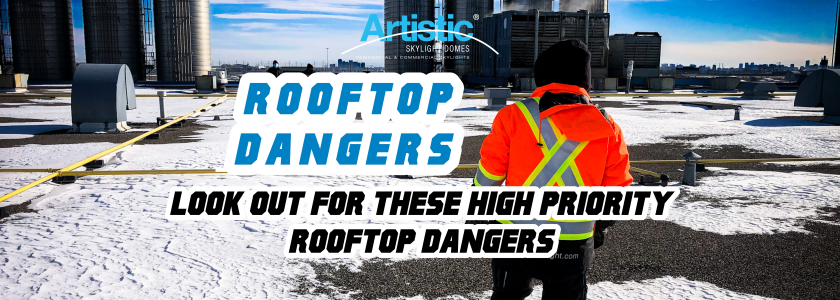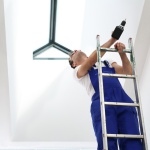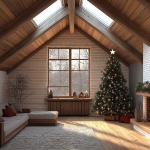
There’s a risk to working on roofs. Whenever the job calls for heading up a ladder, crews must account for the many rooftop dangers that might cause slips, falls, or other bodily harm.
“Roofs present several inherent risks that need to be taken seriously by anyone who works at heights,” says Marco Ferrazzo, Manager with Artistic Skylights. “The upside is these risks can be prevented through proper training, ongoing diligence, and using rooftop products with proven safety measures.”
Going up? Keep the following rooftop dangers on your radar:
- Stability: Older roofs or inefficient materials may fail to support your weight. That’s why it pays to ensure everything on the roof is intact (e.g., trusses, underlayment, etc.) and the site is free of holes, weaknesses, or damages before taking your first step.
- Risky conditions: Rain, wind, snow, and ice pose significant risks to rooftop workers. Double-check the surface conditions of the roof before going up and always take caution around areas with slipping or falling hazards.
- Lack of awareness: It’s not uncommon for rooftop workers to lose sight of the edge and other obstacles while working at heights. As such, make sure to keep a clean line of sight on rooftop boundaries, stay aware of your surroundings and nearby roof fixtures, and remind others to do the same.
- Inadequate training: Without thorough training on roof safety best practices and equipment, you will pose a risk to yourself and others. Comprehensive fall prevention training is essential to accident-free projects.
- Roof pitch: It sounds like common sense, but it’s worth repeating: the steeper the roof, the riskier the job. Before getting to work, make sure you are using the right fall protection equipment, checking the security of the roofing material (e.g., shingles), and taking all appropriate safety precautions.
- Ladder placement: Consider the 4:1 rule for ladder safety: for every four feet of height the ladder rises, the base needs to be one foot away from the wall on which it’s resting. Also, make sure the ladder’s feet are secure and slip-resistant, and that the top has been tied down securely.
- Uncovered openings: This is arguably one of the most dangerous roof hazards present, as uncovered roof openings can be tricky to spot especially when working on a busy jobsite. Be sure to cover any openings that are left uncovered with a material that is able to support considerable weight. Alternatively, install security gates around the opening for maximum effectiveness.
- Skylights: Even with a skylight installed over an opening, it is still considered a fall hazard. It is recommended to fence off around the skylight or to ensure proper tie-off measures are used.
It’s no secret, skylights pose hazards to rooftop workers. With today’s advancement in the industry, there are products that allow for a quick and effective way to mitigating or eliminating these risks. Installing exterior heavy-gauge skylight fall screens is a cost effective way of adding quick security to new or existing skylights. This product is designed to further prevent accidental falls by shielding over top of the skylight lenses. If you are in the process of replacing your old skylights, inquire about Fall Protection Series skylights that have a much more aesthetic feature with all the fall protection requirements built directly into the skylight.
“We know skylights can pose safety risks on roofs, and it’s important that we take these risks very seriously,” says Ferrazzo. “Style and performance are key, but safety always needs to come first.”



